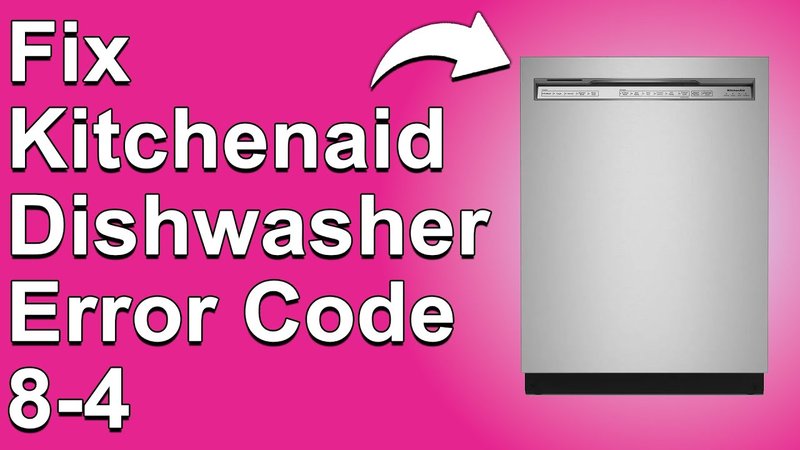
Error OE is essentially your dishwasher’s way of telling you that something is amiss with the water drainage. It’s like your dishwasher waving a little red flag, alerting you that it can’t effectively drain water. Imagine trying to wash dishes in a clogged sink. That wouldn’t work too well, would it? Similarly, your dishwasher needs a clear path to drain the used water efficiently. When this error is left unresolved, it could lead to everything from lingering odors to potential water damage in your home. Let’s delve deeper into why tackling this issue head-on is so crucial.
Understanding the Implications of Error OE
When your KitchenAid dishwasher flashes Error OE, it’s trying to communicate a specific problem with water not draining properly. Think of it like a traffic jam in your dishwasher’s plumbing system. When the water can’t exit smoothly, it gets stuck, much like cars on a busy freeway. As water lingers longer than it should, it begins to affect the cleanliness of your dishes. Over time, you might notice residue or soap scum sticking to what should be sparkling glassware.
Moreover, this drainage problem can lead to some unpleasant smells wafting from your dishwasher. Picture leaving a damp towel in the corner of a room for days. Not great, right? The same principle applies here. Standing water can quickly become a breeding ground for bacteria and mold, which isn’t exactly what you want lingering around your clean dishes. This makes it doubly important to address Error OE promptly to ensure your dishwasher remains fresh and hygienic.
Beyond odor and cleanliness issues, there’s a more serious concern: water damage. If your dishwasher continues to hold excess water due to this error, it increases the risk of leaks. Water could seep out onto your kitchen floorboards or into areas behind your cabinetry, and over time, this can lead to costly repairs. Water damage can warp wood, ruin flooring, and foster mold growth in places you can’t easily spot.
Common Causes of Error OE
You might be wondering, “Why does this error even occur?” Well, several culprits could be at play. One of the most common causes is a blocked drain hose. Imagine the drain hose as the exit ramp from the freeway of your dishwasher. If it’s clogged, say, with food particles or debris, the water simply can’t flow out as it should. This blockage results in the dreaded Error OE because the dishwasher senses that water isn’t draining as expected.
Another potential cause might be the drain pump. The pump’s role is to push water out of your dishwasher. If it’s malfunctioning or has been obstructed by something like a stray fork or spoon (it happens more often than you’d think!), it won’t be able to do its job effectively. In this case, you need to inspect or replace the pump to resolve the issue.
Lastly, the problem could lie with the dishwasher filter. Over time, filters can become gummed up with food remnants and soap scum, much like a lint trap in a dryer. If the filter isn’t cleaned regularly, it can’t trap debris effectively, leading to drainage issues and the appearance of Error OE. Cleaning this filter can often solve the problem and prevent future errors from occurring.
Steps to Resolve Error OE
So, how do you tackle this pesky error code once and for all? First things first, you’ll want to give the dishwasher a break by turning off the power. Once it’s off and safe to work with, start by checking and cleaning the filter. This simple maintenance step can often resolve minor drainage issues. Remove the filter from your dishwasher, rinse it under warm water, and use a soft brush to remove stubborn residues.
Next up, inspect the drain hose. Locate it at the back of your dishwasher and check for any visible kinks or clogs. Carefully detach the hose and use a flexible cleaner or a gentle flow of water to ensure it’s free and clear. This should aid in restoring the proper flow of water out of your kitchen appliance.
If the issue persists, the drain pump may require a more thorough inspection or even a replacement. While it can be tempting to tackle this yourself, it’s sometimes best to call in a professional if you’re unfamiliar with dishwasher mechanics. A trained technician can ensure everything is working as it should and may even spot potential problems before they arise.
Preventative Measures to Avoid Future Problems
You’ve managed to get rid of Error OE, but how do you keep it from returning? Start by making it a habit to scrape off excess food from dishes before loading them into the dishwasher. This simple action goes a long way in preventing food particles from clogging the filters or hoses.
Regularly cleaning your dishwasher is also key. Set aside a bit of time each month to wipe down the interior, check the filters, and run a cycle with a dishwasher cleaner. This keeps your appliance running smoothly and can help avoid stubborn blockages altogether.
Finally, take a moment to familiarize yourself with your dishwasher’s manual. Understanding the ins and outs of your specific model can provide helpful tips tailored to your machine, ensuring you’re aware of any maintenance schedules or parts that might require routine attention. Remember, preventing future errors is much easier (and cheaper!) than dealing with problems as they arise.
In conclusion, while Error OE can be a headache, it’s not an insurmountable one. By addressing it promptly and taking steps to prevent future occurrences, you can ensure your KitchenAid dishwasher continues to serve you well, keeping your dishes clean and your kitchen a happy, leak-free space.